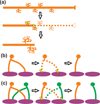Phagocytic glial cells: sculpting synaptic circuits in the developing nervous system
- PMID: 24157239
- PMCID: PMC3907950
- DOI: 10.1016/j.conb.2013.09.012
Phagocytic glial cells: sculpting synaptic circuits in the developing nervous system
Abstract
In the developing nervous system, synaptic connections are formed in excess and must remodel to achieve the precise synaptic connectivity characteristic of the mature organism. Synaptic pruning is a developmental process in which subsets of synapses are eliminated while the remaining synapses are preserved and strengthened. Recent findings have demonstrated unexpected roles for glial cells in this developmental process. These data demonstrate that phagocytic glia engulf synaptic and/or axonal elements in the developing nervous system and disruptions in this process result in sustained deficits in synaptic connectivity. These new findings highlight the importance of glia for nervous system development and function and may shed new light on mechanisms underlying nervous system disease.
Copyright © 2013 Elsevier Ltd. All rights reserved.
Figures



References
-
- Sanes JR, Lichtman JW. Development of the vertebrate neuromuscular junction. Annual Review of Neuroscience. 1999;22:389–442. - PubMed
-
- Hua JY, Smith SJ. Neural activity and the dynamics of central nervous system development. Nat Neurosci. 2004;7:327–332. - PubMed
-
- Katz L, Shatz C. Synaptic activity and the constuction of cortical circuits. Science. 1996;274:1133–1138. - PubMed
-
- Luo L, O'Leary DD. Axon retraction and degeneration in development and disease. Annu Rev Neurosci. 2005;28:127–156. - PubMed
-
- Kano M, Hashimoto K. Synapse elimination in the central nervous system. Curr Opin Neurobiol. 2009;19:154–161. - PubMed
Publication types
MeSH terms
Grants and funding
LinkOut - more resources
Full Text Sources
Other Literature Sources

